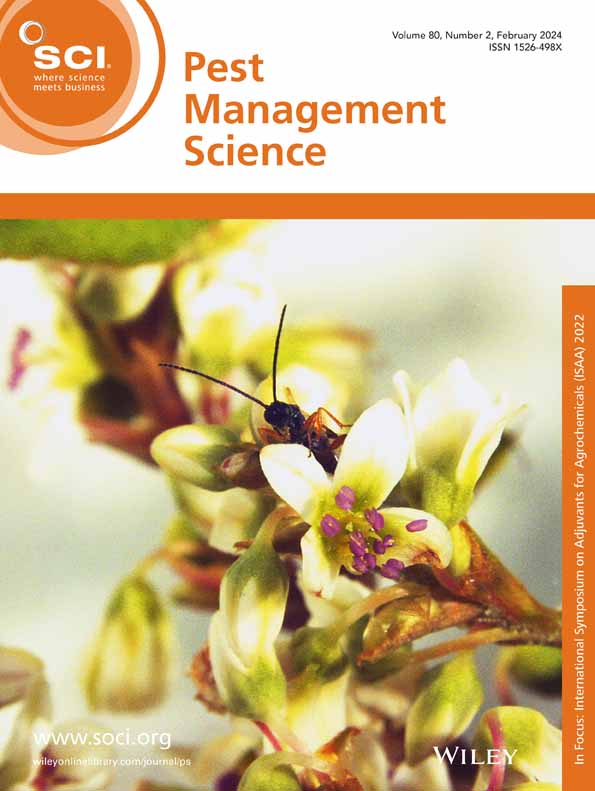黑松草微生物群落变化及其对土壤对乳酸镰刀菌的抑制作用研究进展
IF 3.8
1区 农林科学
Q1 AGRONOMY
引用次数: 0
摘要
富含几丁质的有机土壤改良剂已显示出促进抑制性土壤的巨大潜力。抑制性土壤抑制土传病原体的生长和活性,是化学熏蒸的可持续替代品。本研究的目的是确定黑虻幼虫草(BSFL)、一种新型富几丁质土壤改良剂和其他富含几丁质的改良剂对抑制土壤对番茄枯萎病(Fol)的抑制作用,并评估微生物群落在抑制作用中的作用。将BSFL草料、堆肥、几丁质以及堆肥和几丁质的混合物与土壤混合。一些土壤混合料孵育4个月,以进一步促进微生物群落结构的变化。然后,在培养和未培养的混合土壤中接种Fol,研究Fol对生菜疾病严重程度的降低以及土壤微生物群落的演变。结果与未处理和未处理的土壤相比,几丁质或BSFL杂草孵育土壤的Fol种群密度和疾病严重程度显著降低(P <;0.05)。对几丁质和BSFL禾草培养土壤的微生物群落进行了分析,结果表明:土壤中真菌和细菌的OTUs富集,这些微生物被称为生物防治剂,如Mortierellales、Trichoderma spp.、chetomium globosum、Streptomyces、Bacillus和Sphingomonas。结论甲壳素和BSFL草培养的土壤对Fol有抑制作用。需要进一步研究甲壳素或BSFL的浓度、孵育期或修正率,以提高土壤的抑制能力。©2025作者。《病虫害管理科学》由John Wiley &出版;我代表化学工业协会的儿子有限公司。本文章由计算机程序翻译,如有差异,请以英文原文为准。
Perspectives on microbial community changes produced by Hermitia illucens frass and their impact on soil suppression against Fusarium oxysporum f. sp. lactucae
BACKGROUNDOrganic soil amendments rich in chitin have demonstrated significant potential promoting suppressive soils. Suppressive soils inhibit the growth and activity of soilborne pathogens, being a sustainable alternative to chemical fumigation. The aim of this study was to determine the ability of frass produced from black soldier fly larva (BSFL), a novel chitin‐rich soil amendment, and other amendments enriched in chitin to promote suppressive soils against Fusarium oxysporum f. sp. lactucae (Fol ) and to assess the role of the microbial community on suppressiveness.BSFL frass, compost, chitin and a mixture of compost and chitin were mixed with soil. Some soil mixes were incubated for 4 months to promote further changes in the microbial community structure. Then, incubated and non‐incubated soil mixes were inoculated with Fol to study the reduction of disease severity caused by Fol on lettuce and the evolution of soil microbial communities.RESULTSSoils that were incubated with chitin or BSFL frass showed a significant decrease in Fol population density and disease severity compared to the unamended and non‐incubated soils (P < 0.05). Analyses of microbial community of soils incubated with chitin and BSFL frass were compared to the non‐amended soil, they were enriched on fungal and bacterial OTUs of microorganisms known as biocontrol agents such as Mortierellales , Trichoderma spp. , Chaetomium globosum, Streptomyces , Bacillus and Sphingomonas .CONCLUSIONSoil incubated with chitin and BSFL frass seem to promote suppressiveness against Fol . Further studies on chitin or BSFL frass concentration, incubation period or amendment rate are needed to improve soil suppressiveness. © 2025 The Author(s). Pest Management Science published by John Wiley & Sons Ltd on behalf of Society of Chemical Industry.
求助全文
通过发布文献求助,成功后即可免费获取论文全文。
去求助
来源期刊

Pest Management Science
农林科学-昆虫学
CiteScore
7.90
自引率
9.80%
发文量
553
审稿时长
4.8 months
期刊介绍:
Pest Management Science is the international journal of research and development in crop protection and pest control. Since its launch in 1970, the journal has become the premier forum for papers on the discovery, application, and impact on the environment of products and strategies designed for pest management.
Published for SCI by John Wiley & Sons Ltd.
 求助内容:
求助内容: 应助结果提醒方式:
应助结果提醒方式:


